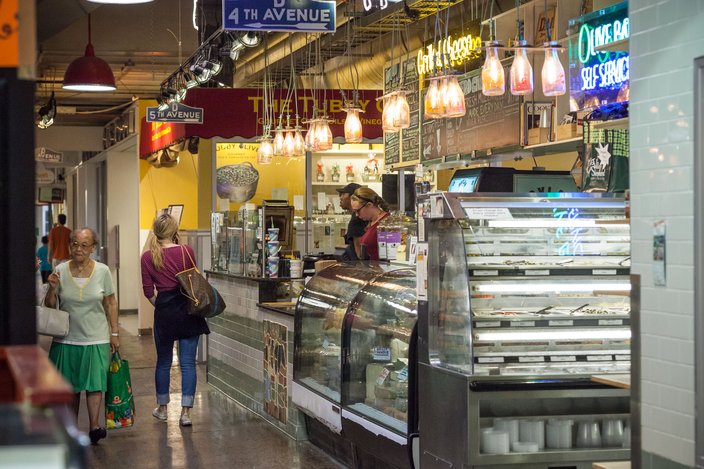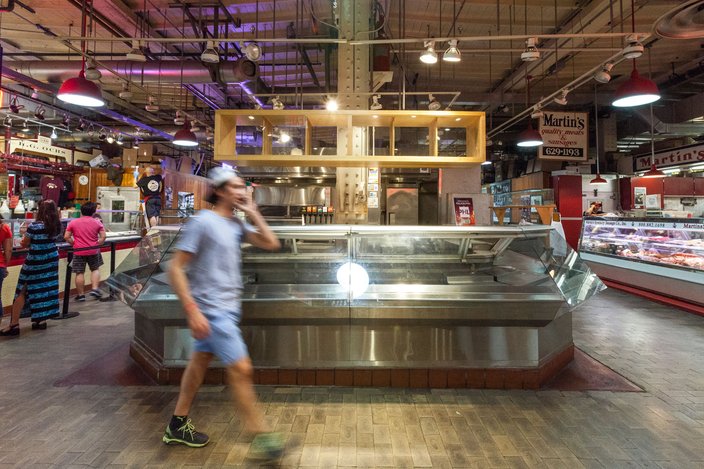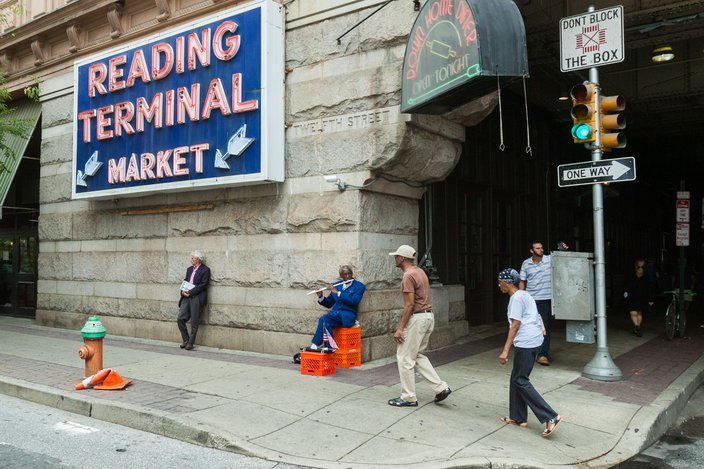
June 23, 2015
 Thom Carroll/PhillyVoice
Thom Carroll/PhillyVoice
Anuj Gupta, the new general manager of Reading Terminal Market, lounges by DiNic's.
Anuj Gupta, now general manager for Reading Terminal Market, peers through an upstairs window over a sprawling crowd of market patrons and merchants interacting below -- like a captain dutifully overlooking the people who keep his ship afloat.
It's a reminder of just how many moving parts need managing to make the shoppers' market, the oldest in the nation, a continued jewel of the seas.
"I know there's pressure [with running this market], but I welcome it," Gupta, who started his role last week, told PhillyVoice.com. "How many chances in a lifetime do you get to have an impact on an icon like this?"
Gupta, previously deputy chief of staff for Mayor Michael Nutter and director of CDC Mt. Airy USA, is taking over the market at a time when waters are calm and winds are steady. When his predecessor Paul Steinke took the helm in 2003, the annual head count was at 4.7 million; as of 2013, that count was 6.2 million. For the first quarter of 2015, the market attracted 1.6 million visitors, up from last winter. By comparison, Lexington Market in Baltimore -- the nearest market of its kind -- reported a total 2014 traffic count of about 2.2 million, despite having 17 more vendors than Reading Terminal Market.
The pressure Gupta's referring to isn't to bring the market back from the brink or plug holes, as would have been the case a mere two decades ago, but to keep the ship moving full steam ahead without ramming into an iceberg.
That iceberg is Market East.
Spring 2017 will be the season to watch for Reading Terminal Market.
Those months will see the opening of the rebranded Gallery, now known as the Fashion Outlets of Philadelphia, which will come with its own set of "artisanal" food operations. By then, the 16,000-square-foot MOM's Organic Market, slated for the East Market project at 11th and Market streets, will also be open. And already a challenger is the combination of Trader Joe's on the west end of Market Street and Whole Foods Market at 10th and South streets -- not to mention an all-too-possible Philly location of the affordable brand of Whole Foods stores targeting 20-somethings that the chain unveiled earlier this year.
But none of those additions is stripping Gupta of his confidence in Reading Terminal Market's appeal to the millions who travel through it each year.
"To the larger question of how to keep crowds coming -- and I say this 110 percent as a customer and now in my job -- if you compare us on quality, diversity and costs, no one can beat us," Gupta said.
It's also the experience of the market, he said, that eases most of his fears.
"I would come here Saturday mornings with my daughter, and we would eat breakfast together and read a book. Saturday mornings here are really casual and peaceful -- you see a lot of families here, and less hustle and bustle," he said. "I'd never think of having an outing like that at Whole Foods, and Reading Terminal lends itself to that."
Gupta: Pretty soon, Whole Foods and MOM’s and some others are going to have a presence here that goes beyond 6 p.m., and they will be direct competition for us. If we can’t figure out a way to make us more accessible, they will start to beat us.
Still, Gupta -- a man who's cool as a cucumber in demeanor and at least as business-savvy as his predecessor Steinke -- is aware that it will take more than feel-good vibes to compete with Whole Foods and MOM's, both of which he acknowledges as challengers on the horizon. What it will take, he said, is giving the market some physical breathing room (an expansion?), strategically picking diverse new merchants (hello, Korean food?) and improved use of technology (Reading Terminal Market App incoming?).
And while the aforementioned thoughts are all running through the mind of Gupta -- who, like any new leader, has the luxury of having a grace period for throwing out the boldest of ideas -- the most pressing matter is the market's hours. Currently, it closes at 6 p.m., just as Center City's swarm of working professionals head to the grocery store to pick up goods for their evening meals.
"Pretty soon, Whole Foods and MOM’s and some others are going to have a presence here that goes beyond 6 p.m., and they will be direct competition for us," he said. "If we can’t figure out a way to make us more accessible, they will start to beat us."
Extending the market's hours isn't quite as simple as scraping off a "six" from the window and making it a seven or eight. Many merchants are owner-proprietors and start their days as early as 5 a.m.
That said, it's also no mystery to vendors that the need to address the market's hours might be an inconvenient truth.
Valley Shepherd Creamery, one of about 80 vendors at Reading Terminal Market. Thom Carroll / PhillyVoice
"I understand that there are plenty of people in the market who are owner-operators and some who travel all the way from Lancaster, but I do think it would be good for the market to be competitive and open late at night," Rebecca Foxman, manager and chef at Valley Shepherd Creamery, told PhillyVoice. "Being closed at 6 p.m., we miss people coming out of work and wanting to get something on their way home. And if you look on Sansom, Chestnut, Walnut, all the restaurants in Chinatown, they're really busy between 7-9 p.m."
Michael Strange, vice president of the Reading Terminal Market Merchants' Association, is also aware of the opportunity cost, and sees the subject coming in the pipeline as next on the agenda.
"One of the things we may have to at least consider to meet [Market East] competition is extending the hours later into the evening, when people aren’t working," Strange, who's also owner of Bassetts Ice Cream (the market's longest-running merchant), told PhillyVoice. "I think that [hours of operation] will be a topic of conversation in the next year, or two years. You won’t see extended hours in the immediate future, but it will be a topic of conversation."
Bassetts Ice Cream, owned by Reading Terminal Market Merchants Association Vice President Michael Strange, has been in business at the market since 1892. The counter, pictured, has never left the market. Thom Carroll / PhillyVoice
It's a conversation that the market's new manager is willing to have, but with merchant needs and a bigger picture in mind all the while.
"A lot of [merchants] are owner-proprietors working the store themselves, and the notion of staying an extra hour or two, I can understand that’s a challenge -- we have Amish who come a long way every day going back and forth, some of them, just learning their weekly schedules, I can’t believe they have the energy and stamina to do it," Gupta said. "You want to be sensitive to those things, but I think we can still get to a point where we’re more accessible. And whether that’s using technology, or more hours, or some combination thereof, we have to get there somehow.”
In a grander sense, the conversation over hours of operation is about Gupta's vision of "accessibility" for the market -- the word most emblematic of Gupta's approach to making changes. And what's implicit in that messaging, is making the market more inviting for the surrounding neighborhood -- one that is increasingly younger.
Demographic data collected by the Center City District estimates that 22 percent of all in-movers in 2013 to Philadelphia -- about 15,000 people -- are moving to Center City; that's more than any other neighborhood. Millennials today make up 47 percent of Center City's population, with an overwhelming majority of newcomers landing in the 18-to-34 age bracket.
In short, that's a lot of Millennial purchasing power -- setting aside the flood of other young professionals who travel to Center City from surrounding neighborhoods for work.
What to do with that knowledge? Gupta has ideas, some of which are abbreviated as follows:
• Reading Terminal Market: the app. Gupta imagines an app that makes the market easier to navigate, is chock-full of recipes (especially for Millennial cooks of the less culinary-inclined variety) and aggregates specials happening in the market. The reason being, there's plenty to miss at the market on your usual route -- even if you're an experienced market shopper. "I walked in for a meeting the other day and walked into The Head Nut, and for the first time took note of their herb and spice racks, which are pretty extraordinary," Gupta said. "I never even knew they existed. ... Having an app can educate people about that."
• Limited-time closures of Filbert Street. Just last Wednesday, the market experimented with closing off neighboring Filbert Street for outside vendors, seating and entertainment as part of the Bio International Convention at the Pennsylvania Convention Center. This is something Gupta said he would, upon further exploration, want to do regularly to allow the market to breathe on a packed Saturday afternoon. "Maybe we play with shutting Filbert down from noon to 4 p.m., putting outdoor seating out there, having pop-up vendors there, having some music there -- not in a way that detracts folks from [inside the market], but allows congestion to spill out into the street so that it eases it a bit," he said. "It creates another reason to come to the market on a continual basis.”
• Diversity of merchants. Though the market is often touted as being at full capacity, it's actually just shy of 80 vendors -- a Center Court vendor space, formerly occupied by George Mickel's Mezze, sits vacant. (Mickel is owner of the long-running By George, as well as the newest addition to the market, Hunger Burger, which opened in February.) The Reading Terminal Corporation's board is currently working with Gupta to determine what will take the space. And while Gupta's mum about what it will be, he's hoping the market can find a merchant -- whether food-maker or purvey -- that complements the market's existing array of offerings while embracing even more diversity. Examples he pointed to: Korean, Caribbean, African and Latin food cultures are all not represented or underrepresented in the market as is. "A great market is a mirror of its city," Gupta said, "and I imagine as the years go on, we'll only become more diverse."
The sole open merchant space at Reading Terminal Market, previously occupied by Mezze. Thom Carroll / PhillyVoice
• Instacart expansion. Gupta said he's interested in working with major employers in Center City to offer Instacart -- an online delivery service introduced under former general manager Steinke -- accounts to employees, looping them in so that they can easily have produce and other goods delivered to their workplace. "We can leverage that exponentially," Gupta said. "Let’s take large employers within a couple blocks: City of Philadelphia has 12,000 or 13,000 employees just within a few buildings, and the city has a centralized messaging system, so imagine if we can set up a corporate account as a benefit for employees, whereby the employer pays for the Instacart account, and employees can submit orders by 1 p.m. or 2 p.m. By the end of the day their groceries are waiting for them." The service could also help manage the market's heavy foot traffic.
The central seating area, which was added by former general manager Paul Steinke in 2012 and is one of the most crowded parts of the market during the day. Thom Carroll / PhillyVoice
• A more welcoming entrance. Enter the market from 12th Street, and you're first greeted with a trash can. That's something Gupta would like to improve upon -- making entry into the market engaging from all sides.
• Bringing the arts to the market. Reading Terminal Market has long been as much about culture as it has been about food. Gupta hopes to amp up partnerships that are already in existence with organizations like FringeArts. Ideally, he said, this would pair well with the idea of regularly shutting down Filbert Street for market events.
• Longer hours. Gupta pointed to the extended-hours issue as among the most-cited so far in his short tenure as general manager. Put simply, it's on his radar, but not something he plans to address before first experimenting more with online ordering.
The most prominent sign for the market is at 12th and Filbert streets, away from Market Street. Thom Carroll / PhillyVoice
• Linking back to Market Street. Beyond the fact that the market isn't immediately visible to a new, unknowing Philadelphian or conventioneer passing through Market Street, the market's historical roots to "High Street" (re: Market Street) makes it almost criminal that Reading Terminal Market has no presence there. Gupta expressed interest in giving the market more prominence on Market Street, especially as PREIT and the Philadelphia Redevelopment Authority continue to finalize plans for the revitalization of the strip. Brian Abernathy, director of PRA, told PhillyVoice it will release a report in the coming weeks that does address new signage at the Reading Terminal Headhouse.
There's also the possibility -- though, not one that Gupta is fully committed to -- of the market expanding into the Headhouse just across from Filbert Street, currently occupied by retail stores like Verizon Wireless and Dunkin' Donuts, as well as a concourse. Any expansion across the street, which was actually already mapped out in a 2009 report released by the Philadelphia City Planning Commission, would have to be negotiated through PRA. They've yet to express interest in such an expansion, though PREIT, which is co-developing the Gallery project, told PhillyVoice it's happy to discuss how it could help the market expand to Market Street, should Gupta and market management decide to pursue the option.
If the market's new direction is to be judged by the quality of its leader, then all bodes well for its future.
Gupta's not exactly short on support. Meryl Levitz, CEO of VisitPhilly, which handles the bulk of the market's tourism advertising, describes him as a man who "understands the importance of people's heads and hearts"; John McNichol, president of the Pennsylvania Convention Center, told PhillyVoice he was "blown away" by Gupta when he interviewed him as part of the Reading Terminal Market Corporation board that hired him.
Truly, you'd be hard-pressed to find a more ideal candidate for the job: He's a foodie by upbringing (his parents own an Indian restaurant in Mt. Airy), well-spoken and open to suggestions without being acquiescent -- a vital quality to have when negotiating the wildly varying personalities and interests of the market's many, many merchants.
But weeding through the sung praises, what will ultimately test Gupta's job performance is his ability to have foresight moving into the second half of the decade -- to know that success doesn't last forever.
"The market has to find a way to sustain that success in a neighborhood that’s growing and changing," Paul Steinke, who left the market in January to run for City Council, told PhillyVoice. "There’s real opportunity to build on the strength the market has, but there will also be challenges of competition and changing demographics that the market will have to keep a keen eye on and follow closely and adapt to."
Thankfully, none of the above is lost on Gupta.
“How I frame it is ‘managing success' -- to continue to be successful," Gupta said. "It’s a wonderful position to be in; I’d much rather work from a position of strength."
The trick to managing that success, he added, is "maintaining appeal to the diversity of the customers the market currently serves."
And, of course, adding a few new customers along the way.



